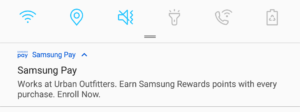Recently, I decided to try out Samsung Pay on my Samsung S8. What I found super interesting with the app was it’s use of geo-fencing.  Geo-fencing is just one of the ways that marketers are attempting to reach their customers at the right place and at the right time.
Geo-fencing is just one of the ways that marketers are attempting to reach their customers at the right place and at the right time.
Marketers can use GPS to circle an area to target customers. As the customer enters or exits that area, an event is triggered and a notification is sent to their phone. In my case, when I walked past an Urban Outfitters, the Samsung Pay app realized where I was and sent a notification. This is great for three reasons:
- I can walk into the store and pay with confidence. I don’t have to walk in and have an awkward conversation with an employee who doesn’t know whether or not their store takes Samsung Pay.
- The frequent notifications show the ubiquity of Samsung Pay.
- Geo-fencing raises awareness for the stores nearby. In modern society, we are constantly multitasking. If we’re not texting or talking on the phone, we are thinking about our endless to do list or about what we’re going to have for dinner. As a result, we are not paying attention to our environment as we are walking by various stores. Geo-fencing raises awareness of the surrounding stores and encourages potential customers to go into the partner stores.
- Finally, this marketing strategy removes the distance and time barrier. The problem with most traditional marketing experiences is that the customer isn’t near the product being marketed. If they are watching an ad on TV, they might think to themselves hmm… maybe I’ll check that out later. But then later comes and the potential consumer is busy with other things and has completely forgotten about the ad. Or maybe their on the computer and see a banner for Urban Outfitters so they click on the link, go to the website and decide that they like one of the pieces but that they’d like to try it out in stores. But again, they’re too busy and never make it out to a store. Geo-targeting suggests a desired target action while the user is in the vicinity of being able to make a purchase. Thus, it provides for right place, right time marketing pushes.
The limitations
 Geo-fencing of course has it’s limitations. First and foremost, apps can only send notifications to users who have downloaded the app. Second, as mentioned above, people are busy. Thus, even if they are made aware of a retailer, they might not have enough time to stop in. Specifically for this case, Samsung Pay is also not taking advantage of the short two-line blurb. Instead of enticing me to go into the stores, Samsung Pay is using the same generic blurb and just swapping out the name. While it works just fine if the goal is to make the user aware of the ubiquity of Samsung Pay, it does not really encourage users to visit the partner stores. This could hinder Samsung Pay as those users will not get increased experience with the service if they do not enter the store.
Geo-fencing of course has it’s limitations. First and foremost, apps can only send notifications to users who have downloaded the app. Second, as mentioned above, people are busy. Thus, even if they are made aware of a retailer, they might not have enough time to stop in. Specifically for this case, Samsung Pay is also not taking advantage of the short two-line blurb. Instead of enticing me to go into the stores, Samsung Pay is using the same generic blurb and just swapping out the name. While it works just fine if the goal is to make the user aware of the ubiquity of Samsung Pay, it does not really encourage users to visit the partner stores. This could hinder Samsung Pay as those users will not get increased experience with the service if they do not enter the store.
What do you think some sample blurbs could have been? How might encouraging me to go into Trader Joe’s be different from encouraging me to go into Urban Outfitters?